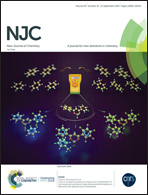The development of a novel biosensor based on gold nanocages/graphene oxide–chitosan modified acetylcholinesterase for organophosphorus pesticide detection
Abstract
Based on the inhibition of acetylcholinesterase (AChE), a novel biosensor, namely gold nanocage/graphene oxide–chitosan nanocomposite-modified screen-printed carbon electrode was prepared for chlorpyrifos detection. Particularly, chitosan (CS) functionalized graphene oxide (GO) had a large specific surface area, good dispersibility and adhesion, so we used them to load more gold nanocages (Au NCs). The Au NCs further extended the surface area and promoted electron transfer due to their unique cage structure, thus amplifying the current signal intensity signal of the biosensor. The as-prepared biosensor exhibited good electrocatalytic capacity for the oxidation of enzymatically produced thiocholine and was capable of detecting chlorpyrifos concentrations as low as 3 ng L−1. The inhibition of AChE by chlorpyrifos was proportional to its concentration in the range of 0.01 μg L−1 to 500 μg L−1. Our results indicated that AChE/Au NCs/GO–CS/SPCE was an effective and biocompatible electrode for detecting low concentrations of chlorpyrifos. In addition, the AChE/Au NCs/GO–CS biosensors showed good stability and repeatability, thus providing a promising tool for the detection of organophosphorus pesticides.



 Please wait while we load your content...
Please wait while we load your content...